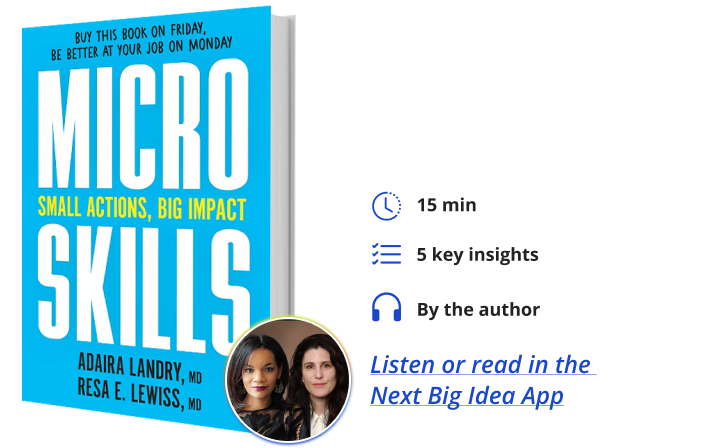Dr. Resa Lewiss is a professor of emergency medicine at the University of Alabama at Birmingham. She is also host and founder of the Visible Voices podcast, which explores healthcare equity.
Dr. Adaira Landry is an Assistant Professor at Harvard Medical School and an emergency medicine physician at Brigham and Women’s Hospital. She is also a keynote speaker, focusing her workshops and lectures on mentor-mentee relationships and workplace efficiency.
Below, co-authors Resa and Adaira share five key insights from their new book, MicroSkills: Small Actions, Big Impact. Listen to the audio version—read by Resa and Adaira—in the Next Big Idea App.

1. Select tasks to take off your plate.
Quitting things used to be hard for me. Older professionals advised, “Say yes to everything.” So, I did. My plate was overfilled with writing projects, speaking gigs, shifts, and meetings all days of the week. As I approached midcareer, people advised me, “Say no more often.” Initially, it felt uncomfortable, and then it became habit-forming. Quitting trivial or irrelevant tasks and keeping fewer items on my to-do list allowed me a deeper dive into developing expertise. It also sparked more joy in my work.
Here are three actions to take tasks off your plate:
- Audit your to-do lists: Weigh the risks and benefits of doing optional work.
- Reduce your FOMO (fear of missing out): FOMO comes from a scarcity mindset. Trust yourself in your decision to take items off your plate.
- Celebrate the JOMO (joy of missing out): With less work on your plate, you will be more focused, deliberate, and intentional.
2. Set limits on time spent in meetings.
For the longest time, I had no control over the number of meetings on my calendar, and there were just too many. While I respect my colleagues, some meetings objectively felt unproductive: no decisions made, no agenda, too much or insufficient time allotted. In fairness, I led suboptimal meetings at times, too. Eventually, I learned to appreciate productive meetings and started creating boundaries around all meetings. Now I ask what the meeting is about and consider if it could become an email instead. I block out windows for certain types of meetings; for instance, Friday mornings are blocked for advising and mentoring meetings. And on Friday afternoons, I have a very high threshold to add meetings. That 1:00 and 5:00 p.m. Friday period is my time to finish up outstanding tasks from the week—or to rest if I am all caught up.
Here are three actions to set limits on meetings:
- Trim meeting lengths. Most meetings do not need to be as long as scheduled. 60-minute meetings often work as 30-minute meetings.
- Meet asynchronously. A lot of work can get accomplished without a meeting. We wrote this book with some meetings but also with cloud-sharing documents, texting, and asynchronous voice messaging.
- Set windows each week where you hold meetings. Except for emergencies, once the slots are filled, that’s it.
3. Establish a compassionate email culture.
I remember when my inbox was flooded with emails. I tried inbox zero, unsubscribe all—they helped a bit, but emails kept coming in from colleagues. That influx was the hardest for me to control. We want to flip the script and instead focus on how you email others. We want to encourage a compassionate email culture where everyone protects their team. For example, write emails whenever it’s convenient for you (e.g. after the kids go to sleep) but schedule them to send during working hours so that you protect the private time of the recipient. Try to send fewer emails so your colleagues get less to their inboxes. It’ll protect your time, too, since if you send fewer emails, you get fewer emails. Also, learn and use email tools, such as BCC (blind carbon copy).
Here are three actions to establish a compassionate email culture:
- Mind the time. Keep emails to your work hours. Draft the email when convenient to you and then schedule it to deploy during work hours and outside of holidays and weekends.
- Add a line to your signature. As emergency doctors, we are on email at all hours and are working at all hours, too. Add a line to your signature explaining to the reader when you respond to emails.
- Select another communication medium. If something is urgent and cannot wait, email may not be the best option. A brief five-minute phone call may resolve the issue.
4. How to network for introverts.
According to Myers-Briggs Company, 56.8 percent of the world is introverted. I am socially adept and not shy; yet I am deeply introverted. These attributes are not in conflict. I can lead a meeting, speak before hundreds or thousands of people, and be comfortable at social events with strangers. This, and I recharge, regroup, and get restored in quiet, solo environments.
Consequently, professional conferences and socializing in large crowds are not my preferred ways to connect. For conferences, I stay in accommodations close to the venue but usually not at the venue. This allows me to escape for quiet breaks when needed. I eat meals or drink coffee solo or organize small groups in lieu of large dinner events. This has worked well as a comfortable way to grow my connections.
Here are three actions to network as an introvert:
- Take time to reflect. Consider the social spaces and conversations where they are most comfortable and joyful for you.
- Protect your energy and recharge your energy. A one-on-one walking meeting can yield a meaningful professional relationship sometimes more than a cocktail party with numerous light conversations.
- Speak with your team about your introvert self. Many may express relief because they feel the same way.
5. The secret to letters of recommendation.
I was applying for my first job and asked my supervisor for a recommendation letter. He said sure, then promptly asked me to write the first draft. My jaw dropped in shock. Is this legal? I soon realized that it made complete sense to draft my own letter. I learned not to wait for other people to save my career. So, if there is something you want, nominate yourself. Ask for others to nominate you. To lessen their work, draft your own letters of recommendation (you know best about yourself and your accomplishments), let them polish them up, and send them in for you.
Here are three actions to draft your own letter of recommendation:
- Offer to write the first draft. Consider even having it ready when you make the ask.
- Build a template. Start by amplifying the letter writer, share your specific highlights, and finally, describe the impact the opportunity would have on your career. Screen for errors like spelling and grammar.
- Supply references. The best letters of recommendation we have read and written included quoted comments from notable people who can speak to your strengths. Curate a list of two to three people to provide a quotation for the letter. Include their contact information for the letter writer.
MicroSkills are not isolated small steps without overlap or applicability. They build upon each other, so any big task seems do-able. When you encounter a large task, an overwhelming project, or a big problem, we hope you pause. Think about the situation. And break it down.
To listen to the audio version read by co-authors Resa Lewiss and Adaira Landry, download the Next Big Idea App today:
































